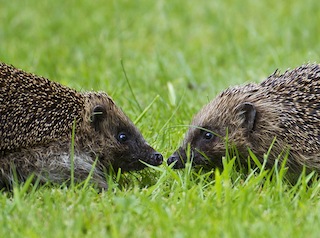 Hedgehogs are not numerous on The Lizard, but keep an eye out on those late evening strolls from spring to autumn.
Hedgehogs are not numerous on The Lizard, but keep an eye out on those late evening strolls from spring to autumn.
Photo: © Natural England/Allan Drewitt
Scientific name: Erinaceus europaeus
Other common names: European Hedgehog, Common Hedgehog
Cornish name: Sort
Conservation status: IUCN, Least Concern; UK Biodiversity Action Plan, Priority Species
What to look for:
- Appearance and colouring : Covered in brown spines which are paler at the tip and base. Pale fur on face and underparts; pointed, mobile nose.
- Size : 23 to 25 cm in length.
- Where : This largely nocturnal and shy mammal is hard to spot. It can live in a variety of habitats but is most common in lowland areas; Hedgehogs are relatively frequent garden visitors. Its overall range extends across western Europe.
- Similar species : None in the UK.
 Famous for rolling itself into a ball with its spines sharply erect when threatened, the Hedgehog can also put on quite a turn of speed when it wants to get away fast. It is largely nocturnal and solitary in habit, and hibernates through much of the winter. The breeding season starts once hibernation ends in the spring. Females raise their litters of pale-spined young alone.
Famous for rolling itself into a ball with its spines sharply erect when threatened, the Hedgehog can also put on quite a turn of speed when it wants to get away fast. It is largely nocturnal and solitary in habit, and hibernates through much of the winter. The breeding season starts once hibernation ends in the spring. Females raise their litters of pale-spined young alone.
The Hedgehog mainly feeds on invertebrates, but will also take bird eggs and some fruits and mushrooms.
Although the population size is fairly stable in mainland Europe, numbers of this endearing mammal are declining rapidly in the UK.
Did you know…?
…The European or Common Hedgehog is the only species of hedgehog found in the wild in the UK, but worldwide there are 17 species across five genera.
…The spiny hedgehog skins were once used for the carding of wool.
More information and references:
Cornwall Mammal Group, 2013. The Mammals of Cornwall and the Isles of Scilly (edited by David Groves). Environmental Records Centre for Cornwall and the Isles of Scilly (ERCCIS), Cornwall.
Published: November 2014
Author: Amanda Scott
Photo: © Natural England/Allan Drewitt
